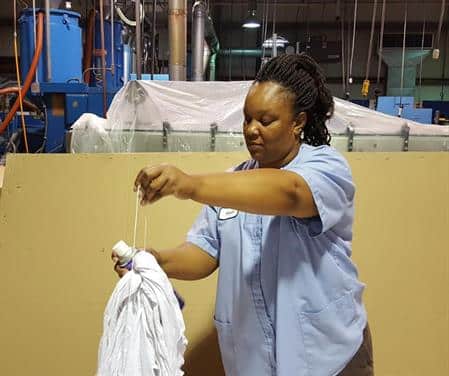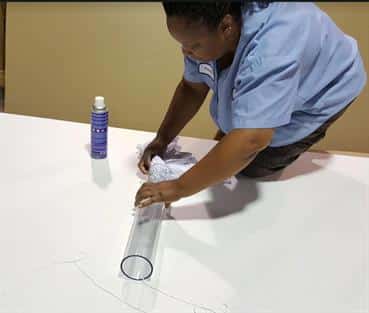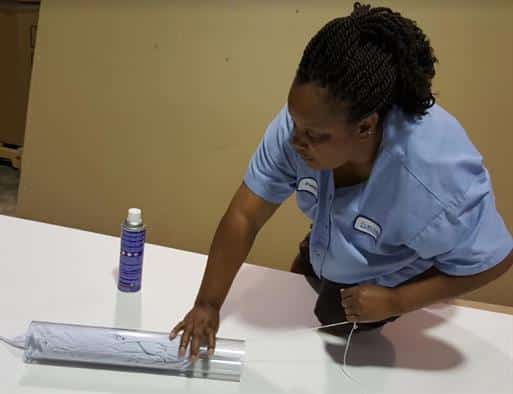Cleaning Butyrate tubing:
Cellulose Acetate Butyrate, as any transparent tubing can accumulate grime, oils, and get scratched by abrasives. Also, it will weather and age due to UV light and oxidizers. When the latter occurs, the tubing cannot be cleaned by traditional plastics cleaners or detergents.
In the above video, you can see a labor-saving way to clean a long stretch of tubing. Just make sure that you have a good cylinder of high-durometer foam (we can supply this for you if you need it). You will also need a good quality string. This method will take your cleaning-saturated sponge through long lengths and sections of tubing. It is excellent for cleaning tubing hanging from a ceiling.
Note of caution!!! Put string on both sides of the sponge. Just in case you hit a snag and your string breaks, the string on the back side of the sponge can pull the foam back out without a major hassle on your part.
1.Aging and yellowing:
If the tubing has yellowed, UV light is the culprit, and the tubing has yellowed throughout; it is not a surface-cleaning issue. Transparent CAB, like most transparent plastics, is amber-colored by nature. The “water clear” color of a newly extruded tube has a blue tint from the resin manufacturer.
Busada tubing, unless specified, is derived from resin with UV stabilizers. Over time, exposure to UV radiation in sunlight or artificial light will degrade the Polymer. UV light consists is non-visible short wavelengths that break down the polymer chains. This process deteriorates physical properties such as loss of impact strength, yellowing, crazing, loss of elongation, and tensile strength or chalking of the surface. The UV stabilizers in Busada tubing absorb UV radiation, but they eventually break down. Just as a color photograph will fade, the plastics tubing’s blue die will fade, and the natural yellow color appears. This cannot be corrected, only delayed by reducing the tubing to UV light.
2.Oil and Grime.
Industrial processes can leave behind all sorts of contaminants. Generally, in butyrate tubing, we recommend a simple procedure. Wet the interior of the tubing and make a cotton-rag ball on a rope. Saturate the rag ball in common household detergent (Eastman has tested products such as Mr. Clean, Spic and Span, Joy detergent, and others to find no degradation through short-term use. Thus, periodical cleaning using this method is advisable.
One might also consider using a chimney-sweep rod kit for the cleaning. The extension rods are flexible and can usually navigate through bends as well as tubing. Others have been successful with Music wire machine augers and related products.
If necessary, concentrated isopropyl or ethyl (denatured) alcohols can be used for cleaning, but this should only be used for short-term cleaning. Tests show that Isopropyl will soften the tubing with two-day exposures.
Here is a recommended mix: Measure three gallons of hot water into a bucket. Add 1 cup of mild detergent and add [ ½ cup bleach OR isopropyl alcohol]. Completely flush out the tubing and allow it to dry.
First step: After making the mix, make a cotton swab that will fit the ID of the tubing snugly. Make the swab long so one sweep will have maximum contact with the tube.
The swab consists of soft cotton cloth tied to a nylon string. The string should be the necessary length to fit inside the entire length of the tubing section that you are cleaning.
You may want to weigh the string down with a non-scratching weight so that you can fling it throughout the tube.

Wet the cotton swab with your cleaning solution (or staticide spray).
Insert the rope of string through the tube. Again, for long lengths, you may want to attach a weight to the string.

Pull the swab through as many times as you need. Repeat the process with a water wipe (or flush the tubing out. If you are applying a staticide, the coating sprays will last until the next cleaning and then it should be reapplied.
Check to see if you need an FDA approved staticide.

3.Dust accumulation.
Dust accumulating on the interior and exterior walls in pneumatic tubing is the result of static charge. We recommend cleaning the tubing (using the cotton-rag ball in point 2) with an anti-static wash. We recommend Staticide products with the rag saturated in water and 15% isopropyl alcohol. Use this method as much as needed, but keep in mind that if the tubing gets wet, new Staticide must be applied. Staticides are available through the ACL Staticide website.
4. Caustic wash (CAB).
This old technology, (patents going back to the 1930s) is to rinse with 10% caustic (10% sodium hydroxide in water) for 2 to 5 minutes. Warmer solutions work better (40C for a faster reaction. This will strip off surface acetyls and butyrls. After cleaning, it should also leave a much more water adsorbing surface on the CAB. This, in turn, should increase static dissipation. Special care needs to be used for this procedure.
5. Abrasions and scratches (CAB and Acrylic)
If the tubing is clean but scratched you may consider a solution of acetone and MEK. Simply put the 60% acetone and 40% MEK solvents into a glass jar and paint the area of the scuffing. It should instantly turn transparent. Do this in low humidity and make sure that no water gets into your solvent. Otherwise, you will develop a white coating. Test your brush so that it is not reactive with your solvent.
6. Sterilization: Isopropal or denatured ethyl alcohol can be used liberally in cleaning Busada tubing. They do not react with the plastic, nor cause fogging. High-heat cleaning is not recommended as butyrate tubing has a softening point at about 170°. If you must use hot liquids, use them quickly.
